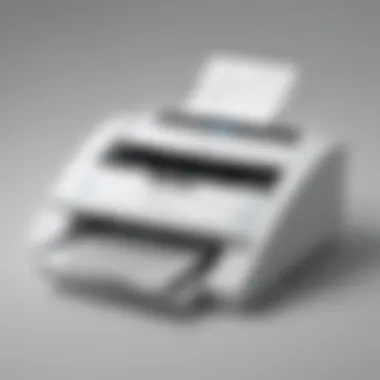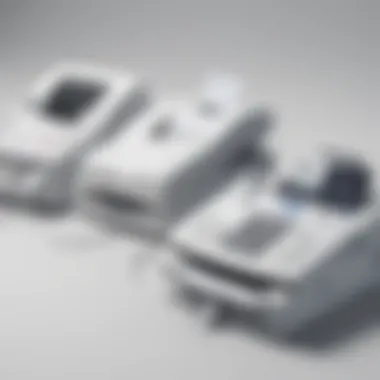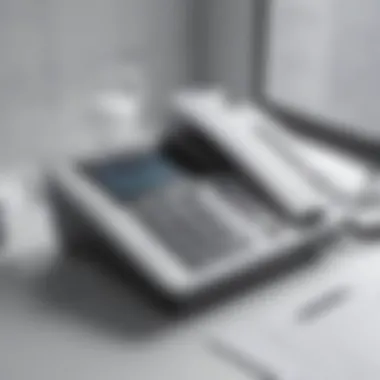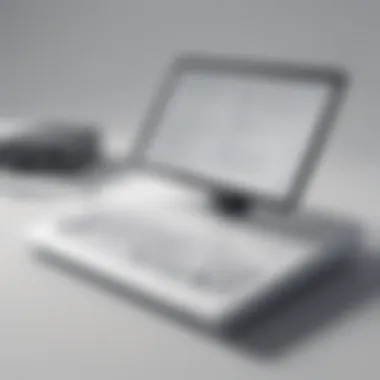Understanding eFax: A Comprehensive Overview


Intro
Fax technology has been a staple in business communication for decades, but the rise of digital solutions marks a significant evolution in this space. The electronic faxing method, commonly known as eFax, merges traditional faxing with modern technology. This convergence not only enhances efficiency but also offers a variety of functionalities that cater to contemporary needs. Understanding eFax involves exploring its core functionalities, advantages, and limitations, while critically analyzing its role in today's business environment.
While fax machines used to dominate the office landscape, the necessity for physical machines has diminished. eFax allows users to send and receive faxes via email or secure web portals. This transition not only reduces overhead costs associated with hardware but also simplifies document management, aligning with digital workflows of small to medium-sized businesses.
In this article, we will delve deeply into various aspects of eFax technology, providing detailed insights on how it operates, its unique features, and its practical applications in a business setting. Additionally, we will explore security considerations and how eFax services compare with traditional faxing systems and competing digital solutions.
What is eFax?
Understanding eFax is critical for businesses that rely on efficient communication methods. The traditional fax system has limitations, such as the need for physical machines and paper, which can be cumbersome and costly. eFax provides a digital alternative that engages with modern technology, improving productivity and workflow.
Definition and Basic Functionality
eFax, or electronic fax, is the process of sending and receiving faxes through the internet rather than using traditional phone lines and fax machines. This method converts documents into electronic files, which can be sent directly to an email address or through an online portal.
The basic functionality of eFax typically involves a user uploading a digital document to a web-based platform or attaching it to an email. The system then converts this file into a fax format and transmits it to the recipient's fax number. This process significantly reduces the need for physical resources, making it more eco-friendly.
Key Components of eFax Technology
Several key components define the eFax technology setup. These elements work together to ensure efficient and secure fax communication.
- Email Integration: Most eFax solutions allow users to send and receive faxes directly through their email. This simplifies the process, as users can handle faxes like any other email attachment.
- Web-based Interfaces: Many eFax services provide web portals where users can manage their faxes. These interfaces usually allow for tracking, scheduling, and accessing documents from anywhere with an internet connection.
- Security Protocols: Security is paramount when dealing with sensitive information. Many eFax services employ encryption methods to protect the data during transmission.
- Storage Solutions: Some eFax services include cloud storage options, enabling users to save fax documents within secure online storage for easy access and organization.
Overall, eFax technology encapsulates essential features that cater to the contemporary business landscape, facilitating a smoother operation and substantial savings.
Evolution of Fax Technology
Evolution of fax technology played a crucial role in shaping modern communication strategies, especially for small and medium-sized businesses. The progression from traditional to digital methods signifies more than just technological advancement; it reflects the necessity for efficiency and adaptability in a fast-paced digital world.
The Transition from Traditional to Digital
The shift from traditional fax machines to digital fax solutions represents a significant transformation in how documents are shared. Traditional fax machines relied on physical telephone lines, which limited the speed and efficiency of document transmission. Users often faced issues like paper jams and busy signals, causing frustration and delays.
With the advent of digital technology, faxing transitioned to electronic formats. eFax services include the ability to send and receive documents via email or dedicated applications. This change has drastically reduced the time it takes to transmit documents. Businesses can now send important files in mere seconds, rather than waiting for a machine to complete a process that could take several minutes.
Furthermore, electronic transmission eliminates the need for physical paper, making it a cost-effective solution. A study indicated that companies can save significant funds since they no longer require ink, paper, or maintenance for traditional machines.
Impact of Internet on Fax Communication
The Internet has revolutionized how we interact with fax technology. As more businesses adopted online communications, eFax has become increasingly significant. Internet-based faxing allows for greater flexibility. Documents can be sent from virtually anywhere, provided there is an Internet connection. This capability is particularly beneficial for remote teams and businesses with multiple locations.
Moreover, online faxing means that documents can be easily archived and tracked. This feature improves organizational efficiency as users can quickly search through past communications without having to sift through physical documents. Security has also seen improvement; many eFax providers implement encryption methods, ensuring that sensitive information remains protected during transmission.
"The transition to eFax is not just about technology. It’s about creating a more streamlined method of communication that adapts to the needs of modern business."
In summary, the evolution of fax technology from traditional methods to digital implementations demonstrates a clear need for efficiency, security, and adaptability. Businesses that embrace eFax benefit from faster communication, cost reduction, and improved overall productivity.
Advantages of Using eFax
The adoption of eFax technology brings several significant benefits, particularly for small to medium-sized businesses. Understanding these advantages is essential for any organization aiming to modernize its communication methods. From financial savings to enhanced security, eFax offers a valuable option in the current digital landscape.
Cost Efficiency


eFax solutions can reduce costs in various ways. Traditional fax machines require maintenance, paper, and physical space, leading to ongoing expenses. By switching to eFax, businesses can eliminate the need for these resources.
- Reduction in Material Costs: With eFax, there is no need to purchase paper or ink. This is a notable advantage in today's paperless offices.
- Lower Operational Costs: eFax services often come with flexible plans that can be adjusted to the needs of the business, reducing expenses associated with underutilized resources.
- No Need for Fax Lines: Businesses save money on separate phone lines traditionally used for faxing.
In summary, while the initial investment in eFax services might be a factor, the long-term savings become apparent as the business scales up its operations.
Enhanced Security Features
Security is a paramount concern for businesses, especially those dealing with sensitive information. eFax technology addresses this through robust security measures.
- Encryption: Many eFax providers implement strong encryption protocols, ensuring that documents remain secure during transmission.
- Compliance: eFax assists organizations in adhering to regulations such as HIPAA or GDPR, depending on the industry. Using eFax can help businesses maintain compliance with legal requirements by securely transmitting sensitive information.
- Access Controls: Digital transmissions can incorporate user authentication processes, limiting access to confidential documents.
These features position eFax as a safe alternative to traditional faxing methods, enhancing data protection and mitigating risks.
Environmental Benefits
The environmental impact of business practices is an increasing concern for many organizations. eFax offers a way to contribute positively to sustainability efforts.
- Reduction of Paper Use: eFax eliminates the need for paper documents, significantly limiting waste.
- Less Energy Consumption: Fewer physical machines mean lower energy consumption and a smaller overall carbon footprint for the business.
- Eco-friendly Archiving: Digital documents are easier to archive without taking up physical space, further promoting efficient resource use.
In a time when consumers are more aware of environmental impact, using eFax can enhance a company's reputation as a responsible business.
Ease of Use and Integration
eFax technology is designed with user-friendliness in mind. Implementations often require minimal adjustments in workflows, making the transition smooth.
- User-friendly Interfaces: Most eFax systems provide intuitive user interfaces, reducing training time and making it accessible for employees.
- Seamless Integration: Many eFax services integrate with existing email systems and document management software, streamlining communication processes without significant alterations.
- Mobile Accessibility: With eFax, users can send and receive faxes from multiple devices, such as smartphones or tablets, facilitating remote work and enhancing accessibility.
Overall, the simplicity of eFax makes it an attractive option for businesses looking to modernize their communication methods without complicating existing processes.
These advantages of eFax highlight its role in improving business efficiency, reducing costs, and contributing positively to the environment. Embracing eFax as a crucial communication tool can significantly streamline operations in a digitally driven marketplace.
Challenges Associated with eFax
Understanding the challenges associated with eFax is crucial for businesses considering its implementation. While eFax solutions offer numerous benefits, there are limitations and concerns that must be addressed to ensure effectiveness and compliance. Without acknowledging these challenges, businesses may face operational difficulties, security risks, and legal issues. Below, we discuss each specific challenge, offering insights into their implications.
Technical Limitations
eFax technology, while advanced, is not without its technical limitations. One major issue is the dependence on file formats. Not all eFax services accept every file type or size, leading to potential hindrances in communication. Companies may experience problems when attempting to send large documents or uncommon file formats. This aspect can be frustrating and may result in delays. Additionally, some eFax providers may have restrictions on sending or receiving multiple documents at once. It can impact workflow during busy hours, especially in fast-paced environments.
Another technical limitation stems from the compatibility with existing systems. Organizations using legacy systems may find themselves facing integration issues with eFax solutions. Moreover, issues such as software bugs, downtime in service, and the reliability of internet connections often affect performance. It's important for businesses to assess whether their current infrastructure supports eFax and to establish contingency plans for when these problems arise.
Dependence on Internet Connectivity
The shift to eFax means that businesses are heavily reliant on a stable internet connection. This dependency can be a double-edged sword. On one hand, it allows for increased flexibility and accessibility. On the other hand, it creates vulnerabilities. An unreliable internet connection can lead to failed transmissions and delayed communications. Small to medium-sized businesses especially need to consider the impact of outages. If an organization operates in an area with unstable internet services, this might hinder the efficiency and reliability of eFax as a communication tool.
Furthermore, organizations may face issues of bandwidth. Sending large faxes could consume significant network resources, leading to slowdowns overall. This is especially important in environments where multiple users rely on the same connection. Adequate bandwidth is critical for seamless operation, and failure to prioritize this could mean substantial delays.
Compliance and Legal Considerations
The integration of eFax into daily operations brings about compliance and legal necessities that organizations must address. For many industries, adherence to regulations such as HIPAA in healthcare or GDPR in data protection is mandatory. Failing to comply can result in penalties or legal action. Therefore, businesses must ensure that their eFax service providers comply with these regulations.
Another aspect of compliance relates to the storage and management of sensitive information. eFax documents should be securely stored to prevent unauthorized access. This is particularly vital for industries dealing with confidential data. Companies must also establish proper procedures for managing and disposing of eFax documents to maintain compliance with data protection laws.


How eFax Works
Understanding how eFax works is crucial for businesses looking to streamline their communication processes. eFax technology replaces traditional fax machines, integrating faxing capabilities into digital frameworks. This shift not only simplifies sending and receiving documents, but it also enhances the overall efficiency of document management in a professional setting.
The Send and Receive Process
The process of sending and receiving faxes using eFax differs significantly from traditional methods. In traditional faxing, a physical machine is necessary. In eFax, this is not the case. Instead, users can send documents as email attachments or upload them directly through a web interface. The eFax provider then converts these documents into a fax format suitable for transmission over phone lines.
The recipient, on the other hand, receives the fax either in digital form via email or through a designated online portal. This dual functionality allows for flexibility and ease of access for users. The entire process can be completed within minutes, which is significantly faster than traditional faxing methods. Moreover, eFax solutions often include tracking features, enabling users to monitor the status of their faxes in real time. This immediate feedback can be essential for time-sensitive documents.
Role of eFax Providers
eFax providers serve as the backbone of eFax technology, ensuring smooth operation and connectivity. These providers maintain the infrastructure and security protocols necessary for transmitting sensitive information. Companies like HelloFax and eFax provide users with the tools needed to operate effectively within this system.
When selecting an eFax provider, businesses should evaluate several essential criteria:
- Reliability: High uptime rates and secure connections.
- User Interface: A simple, intuitive interface is critical for ease of use.
- Integration Options: The ability to connect with existing applications like Microsoft Office, Google Drive, or other document management systems can greatly enhance workflow.
- Customer Support: Access to support is invaluable, especially when technical issues arise.
In summary, understanding how eFax works and the role of providers can directly impact a business’s efficiency and communication. As businesses continue to adapt to the digital landscape, integrating eFax solutions provides not only convenience but also improvements in security and data management.
Applications of eFax in Business
The applications of eFax technology within business sectors are numerous and significant. With its ability to streamline communication processes, eFax has become increasingly important in various industries. Companies leverage this technology to improve efficiency, security, and reliability in transmitting documents. Understanding the applications of eFax allows businesses to understand its role in their operations and how it can enhance their workflows. This section delves into specific industry use cases, highlighting how eFax serves unique needs and challenges.
Use in Healthcare
In the healthcare sector, the use of eFax is crucial for maintaining patient confidentiality while ensuring swift document transmission. Healthcare providers often handle sensitive patient information, making it essential to have secure methods for sending and receiving documents like prescriptions, referrals, and patient records. eFax services are often compliant with regulations such as HIPAA, which ensures that electronic communications meet privacy standards.
Benefits of using eFax in healthcare include:
- Reduction in Paper Waste: By digitizing the faxing process, healthcare organizations can significantly cut down on paper usage.
- Increased Efficiency: eFax allows for instant document transmission, reducing wait times for critical information.
- Enhanced Record-Keeping: Electronic storage of faxed documents simplifies retrieval and auditing processes, contributing to better record management.
eFax in Legal Settings
Legal professionals heavily rely on timely, accurate document transmission. In legal settings, eFax plays a vital role by ensuring that critical documents such as contracts, briefs, and court filings are sent and received quickly. The digital nature of eFax allows for immediate confirmation of receipt, which is essential in the legal field where timing can impact legal proceedings.
Here are some points about the advantages of eFax in legal environments:
- Secure Document Transfer: eFax services utilize encryption and authentication techniques that secure sensitive legal documentation.
- Compliance with Legal Standards: Many eFax services comply with various legal regulations, providing lawyers with peace of mind when transmitting documents.
- Streamlined Communication: eFax mitigates the delays often associated with traditional faxing, allowing legal professionals to maintain momentum in their cases.
Financial Sector Utilization
In the financial sector, eFax technology facilitates the secure transmission of sensitive information, such as loan applications, investment portfolios, and transaction records. Financial institutions benefit from eFax by reducing the risk associated with traditional faxing methods, which can be susceptible to interception.
Key points relevant to eFax application in finance include:
- Speed of Transactions: The immediacy of eFax aids in expediting processes that require quick turnaround times, such as loan approvals.
- Improved Security: With heightened security measures, financial institutions can transfer sensitive information without the fear of compromise.
- Regulatory Compliance: eFax solutions often include features that assist with compliance to financial regulations, such as preserving records for audit purposes.
Overall, integrating eFax into business practices can lead to more productive communication channels. From the healthcare space, where information accuracy is critical, to legal environments that demand compliance and security, to the financial sector’s need for rapid and safe document exchanges, eFax technology is essential in modern business solutions.
Selecting an eFax Service Provider
Choosing the right eFax service provider can significantly influence how businesses manage their document communication. It is essential to understand that not all eFax services are created equal. Selecting a provider with appropriate capabilities ensures reliability and efficiency in sending and receiving faxes. This section delves into crucial elements regarding eFax service providers, focusing on both advantages and specific considerations when making a choice.


Essential Features to Consider
When evaluating eFax service providers, businesses should prioritize essential features that enhance usability and performance. Key features include:
- User Interface: A straightforward and easy-to-navigate interface aids in quick adoption by staff at all levels.
- Compliance Support: Ensure the provider adheres to legal regulations relevant to your industry, such as HIPAA for healthcare or GDPR for businesses operating in Europe.
- Integration Capabilities: The ability to integrate seamlessly with existing software and workflows is vital. Look for services that work well with email programs, CRM systems, and cloud storage solutions like Google Drive or Dropbox.
- Mobile Access: As remote work becomes increasingly prevalent, having access through mobile phones and tablets has become a necessity for many businesses.
- Customer Support: Reliable customer service can make a difference when technical issues arise. Verify the availability of support, like chat, phone, or email assistance.
These features not only ensure ease of use but also foster a smoother transition to eFax technology, making it a less daunting process for those unfamiliar with digital document handling.
Pricing Structures Explained
Understanding the pricing models of eFax service providers is paramount for small and medium-sized businesses. Different providers may come with distinct pricing plans, each designed to cater to varying needs and budgets.
- Pay-Per-Use: This model charges businesses for each fax sent or received. It could be suitable for organizations that infrequently use fax services, keeping costs low and predictable.
- Monthly Subscriptions: Many providers offer tiered subscription services based on monthly fax volume. Select plans may feature limits on the number of fax pages sent per month with costs increasing for higher use. This is beneficial for companies that rely heavily on fax communications.
- Annual Contracts: Some providers offer discounts for those who commit to long-term contracts. While this might save money, consider flexibility and changes in future needs before committing.
It's important to weigh the costs against the expected volume of faxes and hidden charges such as additional fees for international faxes or the purchase of additional features.
When selecting an eFax service provider, scrutinizing both the features and pricing structures becomes essential. Paying closer attention to these aspects not only influences operational efficiency but also assures that the chosen solution aligns well with the organization's specific requirements.
Security Measures in eFax
In the digital landscape, the security of information is paramount, especially for businesses that handle sensitive data. eFax technology, while offering significant advantages in efficiency and convenience, also poses unique security challenges. This section outlines the critical security measures that organizations must consider to protect their fax communications, ensuring that proprietary information remains confidential and secure.
Encryption Standards
Encryption stands out as a fundamental component of eFax security. By converting data into a format that is unreadable to anyone who does not possess the proper decryption key, encryption safeguards sensitive information during transmission. Many eFax service providers implement robust encryption protocols, typically utilizing standards such as AES (Advanced Encryption Standard) and TLS (Transport Layer Security).
For instance, the AES-256 encryption is known for its strength and is widely regarded as a benchmark for securing data. TLS, on the other hand, establishes an encrypted link between the eFax sender and recipient, preventing unauthorized access while the information is in transit. Utilizing these encryption standards provides business with the assurance that their data is well-protected, mitigating the risk of interception during the fax process.
Data Privacy Regulations
Data privacy regulations are another crucial aspect of eFax security considerations. Organizations must ensure compliance with laws such as the General Data Protection Regulation (GDPR) in Europe and the Health Insurance Portability and Accountability Act (HIPAA) in the United States. Such regulations dictate strict guidelines on how personal data should be processed and transmitted, impacting how eFax is utilized as a communication tool.
Following compliance can enhance organizational credibility and trust with clients. Failure to adhere to these regulations can result in significant legal penalties, financial losses, and reputational damage. To mitigate these risks, businesses should choose eFax providers that not only adhere to these regulations but also offer features like automated compliance audits and user tracking capabilities.
"Effective security measures in eFax technology are essential for protecting sensitive data, ensuring both compliance and trust in business communication."
In summary, implementing robust encryption standards and adhering to data privacy regulations are vital for ensuring the security of eFax communications. As businesses increasingly rely on this technology, they must prioritize these measures to safeguard their information and maintain compliance in a regulatory environment.
Future of eFax Technology
The future of eFax technology is a crucial area of focus as businesses increasingly rely on digital solutions. The continued development of eFax systems reflects a commitment to improving communication efficiency. As we move further into an era dominated by digital transformation, understanding the future trends and innovations becomes even more vital. Businesses that utilize eFax can expect to encounter numerous enhancements that not only streamline processes but also bolster security and compliance.
Trends Influencing eFax Development
Several key trends are shaping the future landscape of eFax technology:
- Cloud Integration: Many eFax providers are focusing on cloud-based solutions. This makes accessing and managing faxes more convenient for users. The shift to cloud technology also means more scalability and flexibility for businesses.
- AI and Automation: The application of artificial intelligence in eFax systems is increasing. Automation in processes like document scanning and routing can save time and reduce human errors.
- Mobile Accessibility: As mobile devices continue to dominate how people work, mobile-friendly eFax applications are becoming important. This development enhances the ability to send and receive faxes on-the-go.
- Enhanced Security Protocols: In light of growing concerns about data breaches, eFax providers are implementing advanced security measures. Expect features like two-factor authentication and end-to-end encryption to become standard practice.
These trends indicate a shift towards more integrated, user-friendly solutions that meet the evolving needs of businesses, especially small to medium-sized enterprises.
Innovations on the Horizon
The eFax arena is poised for several upcoming innovations that promise to enhance functionality and user experience:
- Blockchain Technology: The potential for using blockchain in eFax systems is gaining attention. This could offer a secure method for tracking documents, ensuring their integrity during transmission.
- Integration with Other Software: Future eFax solutions are likely to offer seamless integrations with various other business tools. This means organizations can link their eFax systems with CRM, project management, or accounting software.
- Improved User Interfaces: User experience is essential. Enhanced interfaces that make sending, tracking, and managing faxes simpler are expected to emerge. This could involve more intuitive dashboards and mobile applications.
- Interoperability with IoT Devices: The Internet of Things might influence eFax technology too. New features could allow devices to send faxes directly from applications like email, increasing ease of use.
The transition to these innovations will make eFax not only more efficient but also a more powerful tool in the digital communication landscape.
The future of eFax technology seems promising. With ongoing development, eFax will likely become a staple in secure, efficient business communication.



